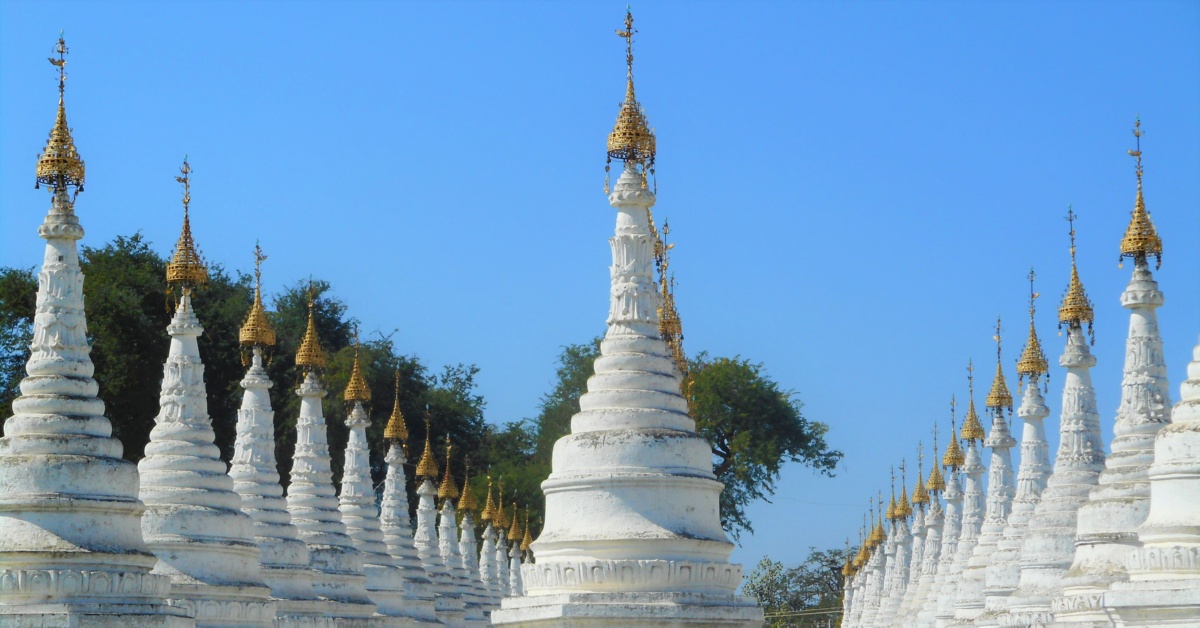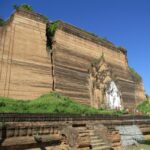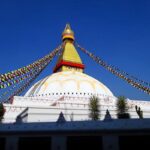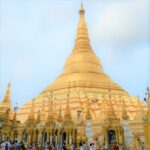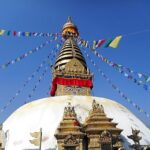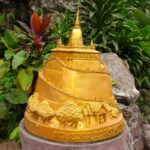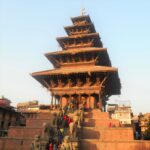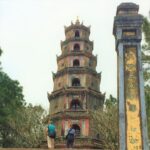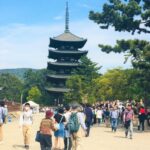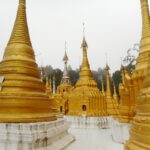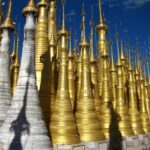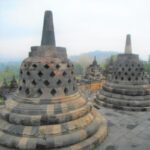When you visit a country in South-East Asia or the far East, you will see Buddhist structures and buildings everywhere. But what are those tower-like structures exactly, and what do you call them? I will explain the differences between a stupa, a temple, and a pagoda so you will be able to tell them apart next time you see one.
Although there are some general rules, these rules do not apply to all structures. You can find exceptions everywhere. Sometimes religious structures are a mix of different religions or beliefs and have their own set of rules. This is a selection of stupas, temples, and pagodas I have visited over the years.
Stupa
In general, stupas are mound-like, often bell-shaped, Buddhist structures that hold religious objects. This can be anything from a hair or a tooth of an important monk or even of the Buddha himself. You cannot enter a stupa structure, but you can walk around it. You generally do this in a clockwise direction (just follow the local worshipers).
Sometimes stupas have a little door or gate in them. These are purely there for monks to make offerings and have access to items that are stored/displayed there. A great example: the 729 stupas at Kuthodaw Pagoda, in Mandalay, Myanmar. Together they contain the largest book in the world: each stupa contains a marble slab with a piece of the Buddhist Pali Canon (standard collection of Buddhist scriptures).
Examples of stupas
A fine example is the Mingun stupa near Sagaing, Mandalay, Myanmar. This is an enormous mound-like (but non-bell-shaped) masonry structure. You can find this stupa on the shores of the Ayeyarwady River. It is visible from far away. It has an interior chamber, but it is not accessible to the public. You are however allowed to climb the stupa. Local children happily volunteer as guides. Several large earthquakes have severely damaged the structure.
The equally impressive Boudhanath stupa in Kathmandu, Nepal, has many prayer wheels on the sides that you can turn as you walk around the stupa base. You can also climb up a bit higher and admire the surrounding buildings and colored prayer flags.
The Borobudur Temple on Java, Indonesia is one of the largest Buddhist structures in Indonesia. The top layer has 72 perforated stupas, containing Buddha statues. This is also a particularly good place for you to visit at sunrise.
Temple
A temple is a Buddhist structure that is designated as a place of worship. Monastics and laypeople use these places for meditation or other spiritual activities. Temples are buildings that can be entered and will often be decorated inside with depictions or statues of sacred figures such as, for instance, the Buddha.
Examples of temples
The Golden Mount Temple (officially called Phu Khao Thong) in central Bangkok is built on an artificial hill. You can climb to the top of the mount and the temple for a splendid view of Bangkok. If you walk through the temple you can climb a set of stairs to the top and admire the pagoda and hang a small bell for your loved ones.
Nyatapola Temple in Bhaktapur, Nepal is a lovely temple that I visited in 2016. It was still standing after the devastating 2015 earthquake. The temple sustained heavy damage, but the lower level was then accessible to visitors.
The Borobudur on Java, Indonesia is the largest Buddhist temple in Indonesia. It is called a temple, but technically it is not a temple as it is not a structure that can be entered. It is actually an enormously large stupa, that draws frequent pilgrims from all over the country.
Pagoda
The word pagoda refers to both temples and stupas. It derives from dagada , the word used for a relic chamber in Sri Lanka. It commonly refers to a place of worship, but it is usually represented as a tower-like structure. Pagodas are quite common in temple complexes around Asia. Different countries and religions have different types of pagodas.
Shwedagon Pagoda, Yangon, Myanmar
The most impressive example I have seen is Shwedagon Pagoda in Yangon, Myanmar. The Buddhist complex is called a pagoda, but at the heart resides its 112 m (560 feet) high gilded stupa. Surrounding the stupa are numerous smaller stupas and temples.
Thien Mu Pagoda, Hue, Vietnam
Thien Mu pagoda is a beautiful 7 story pagoda at a Buddhist temple near the city of Hue, Vietnam. If you take a bicycle from the city center and follow the Perfume River upstream for a few kilometers, you find this lovely pagoda and other Buddhist buildings.
Pura Gunung Lebah Pagoda, Ubud, Bali, Indonesia
The town of Ubud on Bali, Indonesia has stunning 6 tiered pagodas at the Pura Gunung Lebah Hindu temple, just a 10 minute walk from the town center. You will see the temple when you do the Campuhan Ridge Walk.
Kofuku-ji Pagoda, Nara, Japan
Japanese pagodas are quite different. The 5 story pagoda at Kofuku-Ji temple in Nara, Japan has very distinct square roof segments and the ends point up. You can read more about Japanese Buddhism and Shinto in my blog Japanese Shinto and Buddhism: Where Spirits Meet the Buddha.
Chan Tak Pagoda, Pyin Oo Lwin, Myanmar
In Pyin Oo Lwin, Myanmar I found a very fine-looking Chinese temple with a colorful pagoda. The Chan Tak temple also has other religious buildings and a great-looking dragon.
Kyaiktiyo Pagoda, Kyaikto, Myanmar
A very special pagoda is Kyaiktiyo pagoda near Kyaikto, Myanmar. The pagoda itself is perched on top of a giant rock, which hangs precariously on the edge of a mountain top. The rock itself is accessible to men only, who apply their offering of gold leaf to the rock's surface. This is a great place to visit, but not easily accessible. Of course, I applied my own gold leaf offering to the rock.
Bagan Pagodas, Bagan, Myanmar
For a multitude of beautiful pagodas and temples, you should visit Bagan in Myanmar. Over 10,000 were constructed, of which 2,200 are still standing today after multiple earthquakes. You will be able to enter most pagodas, and also climb some of them. More and more are inaccessible these days, because they are unsafe to climb. You can easily spend a week in Bagan to explore many of its pagodas and temples and watch some spectacular sunsets.
On your next trip
Below are a few tips and examples in mind next time you encounter Buddhist structures in Asia. But remember, there are just as many exceptions as there are rules. And nobody will beat you up over making a mistake. 🙂
Just treat any structure with respect and follow local customs if you visit a temple, stupa or pagoda. Just keep these simple rules in mind:
- take off your shoes
- cover your shoulders and knees (dependent on country/location)
- be quiet, don't shout
- do not point your feet at Buddha statues
- do not touch monks or directly offer them anything.
But most of all enjoy the impressive surroundings and atmosphere of these beautiful places.


